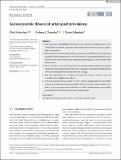Files in this item
Socioeconomic drivers of urban pest prevalence
Item metadata
| dc.contributor.author | Sutherland, Chris | |
| dc.contributor.author | Greenlee, Andrew J | |
| dc.contributor.author | Schneider, Daniel | |
| dc.date.accessioned | 2021-06-04T16:30:02Z | |
| dc.date.available | 2021-06-04T16:30:02Z | |
| dc.date.issued | 2020-09 | |
| dc.identifier | 272468536 | |
| dc.identifier | a31f5e62-75ff-41cb-9989-0d9fbb50a4bc | |
| dc.identifier | 85100716613 | |
| dc.identifier.citation | Sutherland , C , Greenlee , A J & Schneider , D 2020 , ' Socioeconomic drivers of urban pest prevalence ' , People and Nature , vol. 2 , no. 3 , pp. 776-783 . https://doi.org/10.1002/pan3.10096 | en |
| dc.identifier.issn | 2575-8314 | |
| dc.identifier.other | Bibtex: sutherland2020socioeconomic | |
| dc.identifier.other | ORCID: /0000-0003-2073-1751/work/87404657 | |
| dc.identifier.uri | https://hdl.handle.net/10023/23309 | |
| dc.description | Funding: We thank the National Socio-Environmental Synthesis Center (SESYNC) under funding received from the National Science Foundation DBI-1052875, for supporting the workshop series ‘Socio-Spatial Ecology of the Bed Bug and its Control'. | en |
| dc.description.abstract | 1. Bed bugs have re-established themselves as a common household pest in the United States and pose significant public health and economic concerns, particularly in urban areas. 2. Documenting the scale of the bed bug resurgence and identifying the underlying predictors of the spatial patterns of their incidence is challenging, largely because available data come from biased self-reporting through local government code enforcement. 3. Here, we make use of a novel source of systematically collected data from periodic inspections of multifamily housing units in Chicago to investigate neighbourhood drivers of bed bug infestation prevalence in Chicago. 4. Bed bug infestations are strongly associated with income, eviction rates and crowding at the neighbourhood level. 5. That bed bug prevalence is higher in lower-income neighbourhoods with higher levels of household crowding and eviction notices provides unique empirical evidence of the disproportionate allocation of public health burdens upon neighbourhoods facing multiple dimensions of disadvantage. | |
| dc.format.extent | 8 | |
| dc.format.extent | 825509 | |
| dc.language.iso | eng | |
| dc.relation.ispartof | People and Nature | en |
| dc.subject | Bed bugs | en |
| dc.subject | Metapopulation | en |
| dc.subject | Public health | en |
| dc.subject | Socioeconomic | en |
| dc.subject | Spatial ecology | en |
| dc.subject | GF Human ecology. Anthropogeography | en |
| dc.subject | RA0421 Public health. Hygiene. Preventive Medicine | en |
| dc.subject | DAS | en |
| dc.subject | SDG 3 - Good Health and Well-being | en |
| dc.subject | SDG 11 - Sustainable Cities and Communities | en |
| dc.subject.lcc | GF | en |
| dc.subject.lcc | RA0421 | en |
| dc.title | Socioeconomic drivers of urban pest prevalence | en |
| dc.type | Journal article | en |
| dc.contributor.institution | University of St Andrews. Statistics | en |
| dc.contributor.institution | University of St Andrews. Centre for Research into Ecological & Environmental Modelling | en |
| dc.identifier.doi | 10.1002/pan3.10096 | |
| dc.description.status | Peer reviewed | en |
This item appears in the following Collection(s)
Items in the St Andrews Research Repository are protected by copyright, with all rights reserved, unless otherwise indicated.

